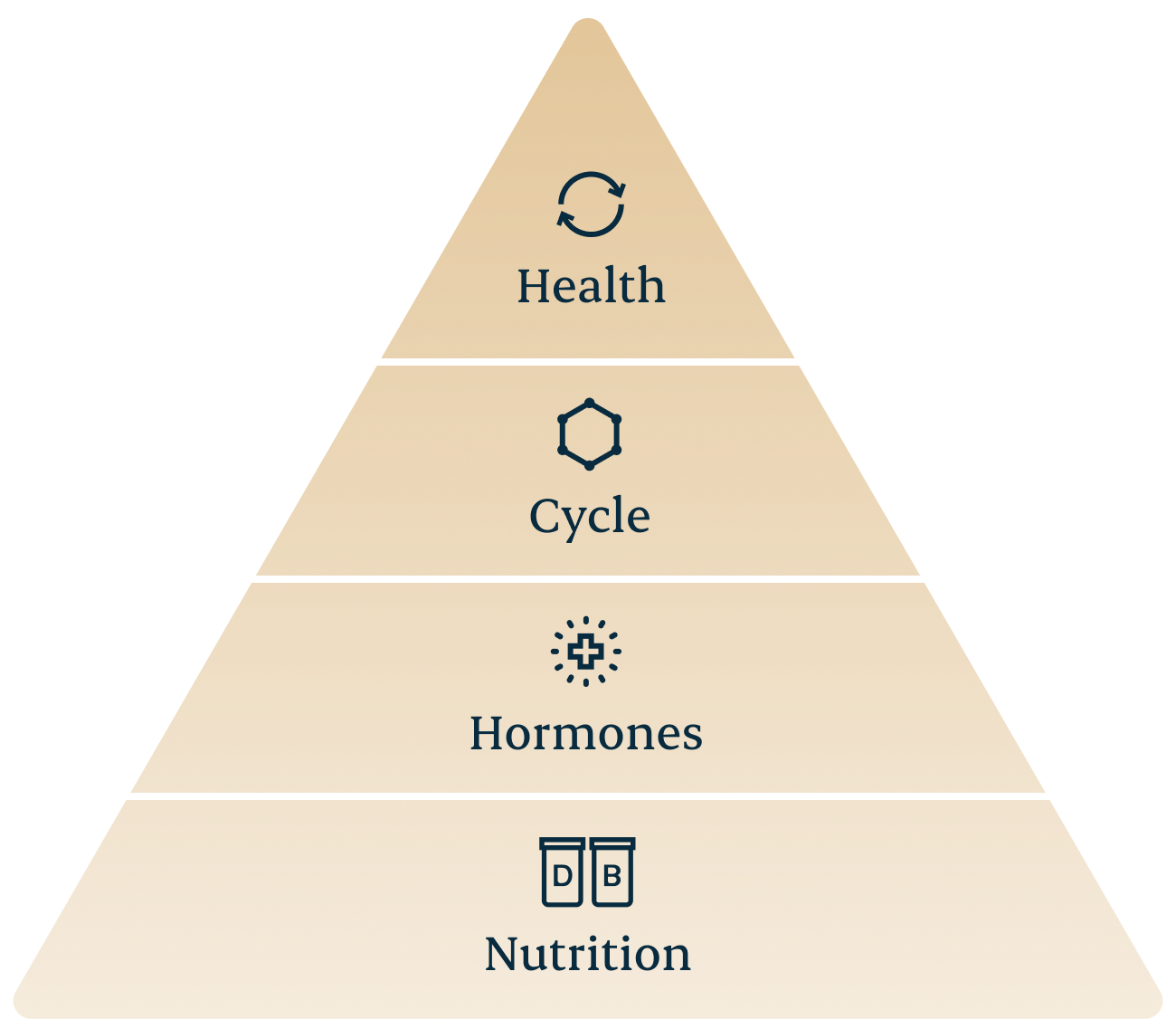Nutrient deficiencies can cause hormonal imbalances, that increase the likelihood and severity of conditions like PMS, infertility, and diabetes.
Proper nutrition is an important part of holistic preventative care, that is critical for both immediate and long term health.

Targeted, evidence-based formulations for women

Period Days 1-15
DailyBasis One Formulation
Why We Made This
DailyBasis One is designed to replenish the nutrients needed at the end of menstruation, supporting the body as it prepares for ovulation during the follicular phase.
The slow rise in estrogen during this phase is often felt through increased energy levels, heightened creativity and increased focus.
How the Ingredients Work
Our pre/probiotic blend helps restore and maintain balance in the intestinal microbiome.
Thiamin, niacin, CoQ10, and riboflavin support the natural increase in energy throughout phase one (the follicular phase) of the cycle.
Vitamin A, Vitamin C, Vitamin E, and greens have potent antioxidant properties that protect follicles from damaging free radicals that accumulate during growth. Lutein, which may support reproductive tissue health, and arginine, which promotes healthy circulation and blood flow also support adequate follicle development.
During this phase, delicate reproductive tissue can be vulnerable to oxidative stress (natural forms of stress from the body and the environment). DB1 includes antioxidants like Vitamin C and Vitamin E to help protect against cellular stress.

Period Days 16-30
DailyBasis Two Formulation
Why We Made This
DailyBasis Two is designed to support the body through the significant drop in estrogen and steady rise in progesterone during this phase and help mitigate associated negative symptoms (PMS).
Women often feel the effects of this hormonal fluctuation more than in the follicular phase because of the increase in body temperature (also known as Basal Metabolic Rate/BMR) caused by the rise in progesterone. Associated symptoms are fatigue, anxiety, bloating, cramps, breast tenderness and increased appetite.
How the Ingredients Work
Insulin resistance, which reduces the body’s ability to efficiently process carbohydrates, tends to increase during this phase of the cycle. DB2 includes a blend of prebiotic fibers, tissue-supportive botanicals, protein, and healthy fats to help restore glycemic balance, which is important in preventing blood sugar spikes.
During this phase, the hormonal shift to progesterone contributes to PMS symptoms often felt during this phase like anxiety, mood swings, and lack of focus. Mood hormones like serotonin, dopamine, and GABA often dip when progesterone levels rise, contributing to these symptoms. DB2 includes lysine, folate, Vitamin B6, and Vitamin B12 which help the body regulate the production of these critical mood hormones.
DB2 provides a blend of powerful antioxidants including curcuma, ginger, and quercetin, that may help regulate the body's inflammatory response and increase blood flow to help relieve symptoms associated with inflammation during this phase. These ingredients are also powerful in increasing the production of prostaglandin, a chemical made and released by cells that help the body respond to situations like an injury, a stressful situation, or a virus.
DB2 contains a diverse spectrum of botanicals and phytonutrients that support immune function by modulating cytokine production. Cytokines are signaling molecules released by immune cells in the body in response to harm like viruses or bacteria. Cytokines communicate with the rest of the body to tell the immune system to kick into gear, coordinating an effective immune response.
When excess hormones, specifically estrogen, are not properly metabolized and remain in the body they can lead to unwanted symptoms like breast tenderness, digestive issues, uterine discomfort, and headaches. Over long periods, excess hormones can lead to greater health issues like increased risk of certain types of cancer. DB2 contains botanicals like curcuma which help support the body's natural systems for detoxification and elimination.
The hormonal fluctuations during this phase may affect the gut, leading to gut inflammation, increased cravings, irritability, and digestive discomfort. DB2 includes a blend of pre and probiotics that help to rebalance the gut microbiome.

Why proper nutrition matters for the menstrual cycle
Enabling Hormone Balance
Proper nutrition at the right time of the month is essential for the menstrual cycle because it supports the hormonal fluctuations that regulate key functions such as follicle growth, ovulation, and the shedding of the uterine lining. Providing adequate nutrients when the body needs them most ensures proper hormone production and metabolism, maintaining the balance of estrogen and progesterone throughout the cycle. This hormonal balance is crucial for cycle regularity and reducing negative symptoms.
Replenishing key nutrients
During menstruation, the body loses blood and important nutrients, especially iron. Iron is needed to make hemoglobin, the protein in red blood cells that carries oxygen throughout the body. Not getting enough iron can lead to feeling tired, weak, and having trouble concentrating. In addition to iron, women also lose other vital nutrients like magnesium, vitamin B6, and zinc, which help regulate hormones, provide energy, and support the immune system. It's also important to consume enough calcium and vitamin D to keep bones strong, as hormone changes during the menstrual cycle can affect bone health.

Why supplementation is often needed
Did You Know: 70% of menstruating women experience cycle-related nutrient deficiencies.
Low Nutrient Density in Food
Today’s crops contain much lower levels of essential nutrients such as calcium, iron, vitamin B2 because of the deteriorating quality of crop soil caused by modern farming practices and nutrient loss during food transportation.
Limited Absorption
Highly processed foods, medications, and other environmental toxins can limit the body's ability to absorb nutrients from food. This is why we source the most bioavailable nutrient forms in DailyBasis to ensure maximum absorption and effectiveness.
Understanding the menstrual cycle phases
The cycle is typically 28-35 days and is driven by five key hormones: estrogen, progesterone, follicle-stimulating hormone, luteinizing hormone, and testosterone.

Follicular Phase • Days 1 - 14
Energy, focus, sex drive and social connection rise. Calorie need and insulin resistance fall.
Inside the ovaries are small follicles, each containing an immature egg. A rise in FSH levels marks the beginning of this stage, triggering the maturation of several follicles. Though multiple follicles begin growing, one matures more rapidly within a cycle. This dominant follicle releases estrogen, halting FSH production. As FSH levels drop, the other follicles halt their growth and are reabsorbed by the body.
Ovulation Phase • 36 Hours
Peak mood, energy and sex drive. You're highly fertile and feeling your best.
This short phase is the only time during the cycle where pregnancy can occur. Just before ovulation, estrogen levels continue to rise, prompting the release of LH. Within about 36 hours, LH peaks, triggering ovulation. During ovulation, the dominant follicle bursts, releasing the mature egg. The egg then travels through the fallopian tube, a narrow passage connecting the ovaries to the uterus, where it waits for potential fertilization by sperm.
At this time, all hormones, besides progesterone are at an all-time high which may impact mood. For example, estrogen boosts serotonin, a brain chemical that enhances mood and energy levels.
Luteal Phase • 7 - 14 Days
Energy, mood, and sex drive reduce. Appetite, calorie need and insulin resistence rise.
After ovulation, the ruptured follicle transforms into a temporary structure called the corpus luteum. Its main job is to release progesterone, which thickens the uterine wall, creating a welcoming environment for a potential fertilized egg. If fertilization happens, the egg attaches to the uterine wall. Otherwise, both the egg and corpus luteum gradually dissolve into the uterine lining.
During the luteal phase, many women experience unwanted symptoms and premenstrual syndrome (PMS).
Menstruation • 3 - 5 Days
Mood, energy, and sex drive are at their low point. Bleeding occurs and calorie needs are high.
Most people know this as the period. The reason why it sheds via blood, is because the uterine lining includes blood vessels and tissue debris.
During menstruation, progesterone levels slowly drop reducing any negative symptoms that may be felt due to high progesterone levels.
What is a hormone?
Hormones are tiny chemical messengers that regulate bodily functions such as metabolism, growth and development, mood, and reproduction. They are produced and secreted by glands, organs, and tissues in the body, all of which compose the endocrine system.

The menstrual cycle is often referred to as the fifth vital sign.
The menstrual cycle can serve as a tool to understand functions in the body like healthy hormone balance. This is similar to how blood pressure, heart rate, body temperature, and respiration are indicators of health.
